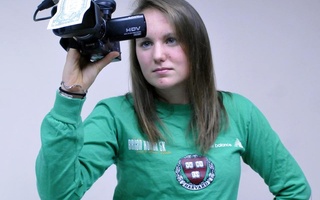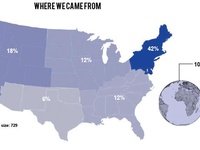
In a year marked by a major cheating scandal at Harvard, more than 30 percent of graduating seniors admit they have cheated on a homework assignment during their four years as undergraduates.
Fewer say they have cheated on an exam or on a paper or take-home assignment—about 7 percent for each type of assessment.
But when asked how many of their classmates had cheated, students’ estimates were much higher. They guessed, on average, that 53 percent had cheated on homework, 32 percent on papers, and 18 percent on exams.
Whether the rate of cheating stands at 30 percent or 50 percent, students on the whole were not optimistic that an honor code—which the Committee on Academic Integrity proposed in March—would make Harvard students any more honest. Just 25 percent said they felt an honor code would reduce cheating.
The numbers come from a survey of the Class of 2013 conducted by The Crimson from May 11 to May 21. Nearly half of the senior class—780 respondents—answered questions on topics ranging from drug use to House satisfaction to post-graduation plans. We assume the sample is a random selection and therefore discount any selection bias.
DO YOU KNOW WHERE YOU’RE GOING TO?
The results paint a picture of the class that graduates this week.
On geography:
• 42 percent came to Harvard from the Northeast. 55 percent will stay in the region after graduation.
• Though 10 percent of students are international residents, 17 percent will be living in foreign countries next year.
• 27.4 percent of the class grew up in urban areas; 64.1 percent come from suburbs; and 8.5 percent come from rural areas. These numbers look quite different from the general breakdown of the U.S. population: According to the 2010 U.S. census, 71 percent of Americans live in cities, 10 percent in suburbs, and 19 percent in rural areas.
On post-graduation plans:
• 61 percent of graduates will be employed next year. 18 percent will enter graduate school right away. The rest will pursue fellowships or travel or are among the 10 percent who have not yet determined their post-graduation plans.
• Of those who will be working, the most popular industry is consulting, drawing 16 percent of employed seniors.
• Another 15 percent will be working in finance, nearly doubling the 9 percent who entered the sector last year but still paling in comparison to 2007, when before the financial crisis, 47 percent of graduating seniors went into finance.
• The next runner-up is the technology and engineering sector, which 13 percent of the employed members of the Class of 2013 will enter.
Asked what industry they would like to be working in ten years from now, students made very different choices.
• The consulting sector went from the very top choice to the very bottom. Just 1 percent see themselves as 32-year-old consultants.
• 5 percent said they still want to be working in finance.
• Health was by far the dominant field of choice in students’ 10-year plans, attracting 20 percent of students. Just 7 percent will enter the industry right away—the years it takes to get through medical school likely account for much of this difference.
• 11 percent would like to be working in arts, sports, or entertainment, though just 5 percent will start out there.
• 9 percent envision a career in government or politics, though only 4 percent will pursue one right away.
PAY DIRT
Salary, of course, plays a large role in determining students’ plans just out of college. The average employed graduate will make roughly $60,000 in his or her first year out of Harvard, according to the survey results. But salaries vary tremendously across industries.
• Among students working in consulting, the most popular field, 72 percent expect to earn between $70,000 and $90,000.
• In the nearly equally popular financial sector, salaries are even higher—a full 21 percent of students entering that field will earn more than $110,000 in their first year on the job.
• And technology can be still more lucrative—almost half of students entering the field will make $90,000 to $110,000 in their first year, and some will make even more.
• For the 12 percent of employed students who will work in education—largely thanks to the popularity of Teach for America—70 percent expect to make between $30,000 and $50,000. Another 15 percent will work for less than that, and 9 percent do not yet know their salaries. Only 6 percent expect to earn more than $50,000, and none more than $70,000.
Salary differs noticeably between male and female students. Men are much more likely to appear in the highest pay brackets than women: Of the students who expect to earn more than $110,000 in their first year of work, three-quarters are male. Of those who will earn $90,000 to $110,000, men represent nearly two thirds. And those numbers come from a pool of respondents which included more women than men, suggesting that the true tallies are in fact slightly more weighted in men’s favor.
The difference in industries chosen by male and female students partially accounts for the difference in pay. Men enter finance, consulting, and technology at higher rates than women, while more women pursue education, media, and health after college.
But industry alone does not explain the wage gap. Among students entering finance, men are still nearly four times as likely to earn more than $110,000 per year, and three times as likely to earn $90,000 to $110,000. Admittedly, the sample sizes are small. But the same holds true in consulting. And in technology and engineering, 79 percent of men expect to make more than $90,000, compared to just 44 percent of women in the same field.
SEX, DRUGS, AND PRIMAL SCREAM
Some differences between men and women might be simpler to explain than the complex factors behind these differences in pay. Take porn.
Men like it so much that 52 percent of them watch it online at least once a week. 14 percent of male students have never watched porn at all. But among women, just 6 percent watch porn as frequently as the majority of the men, and 63 percent have never watched any.
On drinking and drugs:
• Nearly a quarter of the class said they drink more than twice a week.
• 9 percent never drink, and 7 percent drink less than once a month.
• Among students who drink, 60 percent started before they came to Harvard (though 10 percent waited until they graduated from high school).
• At Harvard, most started right away, but 9 percent waited until they turned 21.
• 38 percent of students have tried marijuana, and 3 percent use it more than twice a week. Of marijuana users, 44 percent started at Harvard; the rest started before college.
• Almost a quarter of the class uses tobacco at least occasionally, with about 40 percent of users having started at college.
• 16 percent of the class has tried at least one of cocaine, ecstasy, mushrooms, LSD, and other illicit substances. Very large majorities of those who have used these drugs first tried them after starting college.
• 9 percent of the class has used drugs like Adderall and Ritalin, which are prescribed for attention deficit disorders but often abused by students who hope the pills will help them focus on their studies.
The survey also questioned students about their sex lives, finding that 72 percent enroll at Harvard as virgins and 27 percent graduate without having sex. Of those who do have sex at Harvard, most have just one partner during their four years, but 7 percent of students have 10 or more sexual partners in college.
The daring do it in the library—13 percent of the class, it turns out. Sex in Widener is the least commonly achieved of the “big three” tasks known to Harvard students: 23 percent have urinated on John Harvard’s shiny foot, and 32 percent have run Primal Scream. Just a few hardy folks—4 percent of the class—accomplished all three.
HEALTH AT HARVARD
Students reported being quite happy during their time in college—on average, they rated their happiness at 3.87 on a one-to-five scale, with higher numbers representing more positive feelings.
They rated their satisfaction with their Houses, on average, at 3.92, and gave even higher marks to their concentrations—4.04 on the one-to-five scale, though 27 percent said they would pick a new concentration if they could start over.
But mental health, long a cause for concern at Harvard, has again emerged at the forefront of campus conversation this year, especially after an anonymous opinion piece in The Crimson about a student’s struggles handling schizophrenia sparked a protest outside University Hall. And the survey results show that frustration with Harvard’s mental health services extends far beyond one anonymous writer.
• 39 percent of respondents said they sought some form of mental health care during their time at Harvard.
• 29 percent visited Mental Health Services, 17 percent visited the Bureau of Study Counsel, 12 percent visited an off-campus professional, and 4 percent used a peer counseling group.
• UHS received an average satisfaction rating of 2.9, while the Bureau of Study Counsel’s lesser-used therapy sessions earned a 3.5 rating. Those who received mental health care off campus were most satisfied, giving their treatment a 4.0 rating.
Sexual assault also loomed large in campus dialogue during a school year that started with two rapes reported on campus in a span of five days over the summer. Though the Harvard University Police Department announced that the two assaults were the first stranger rapes reported at Harvard in 12 years, students still voiced safety concerns as they returned to campus.
In the survey, 45 people—41 of whom were women or transgender students—said that they had been sexually assaulted at Harvard. Just eight of those victims said they reported the assault to Harvard administrators. And just one, a male victim, went to the police.
The average self-reported GPA was 3.63. While the mean self-reported GPAs of varsity athletes and of students on financial aid were slightly lower than this average, the differences were within the margin of error at a 95 percent confidence interval. The class saw little change in religiosity from the beginning to the end of college. Twenty percent of the class reported never dating anyone during their time in college. The numbers quantifying the Class of 2013 go on and on.
But perhaps one number speaks loudest of all.
Ninety-three percent: That’s the number that, given the chance to do it all over, would choose Harvard again.
—Julie M. Zauzmer can be reached at jzauzmer@gmail.com. Follow her on Twitter @JulieZauzmer.
—Gautam S. Kumar, E. Benjamin Samuels, and Zoe A. Y. Weinberg contributed to the reporting of this article.
Read more in News
Magic, Magic, MagicRecommended Articles
-
Soaking Up Some Timeless Fen-RaysAppearances can be deceiving. I stretched my legs over recently emptied seats, eased my body backwards, tossed my face in
-
National SportsGRAPEFRUIT LEAGUE St. Louis (N) 000 030 011--5 10 0 Boston (N) 010 200 000--3 6 3 Cincinnati (N) 013 010 200--7 10 0 Philadelphia (N) 200 110 100--5 11 2 Detroit
-
 Rant: Filming on Campus
Rant: Filming on Campus -
 Eliot House
Eliot House -
 Base Salary
Base Salary














